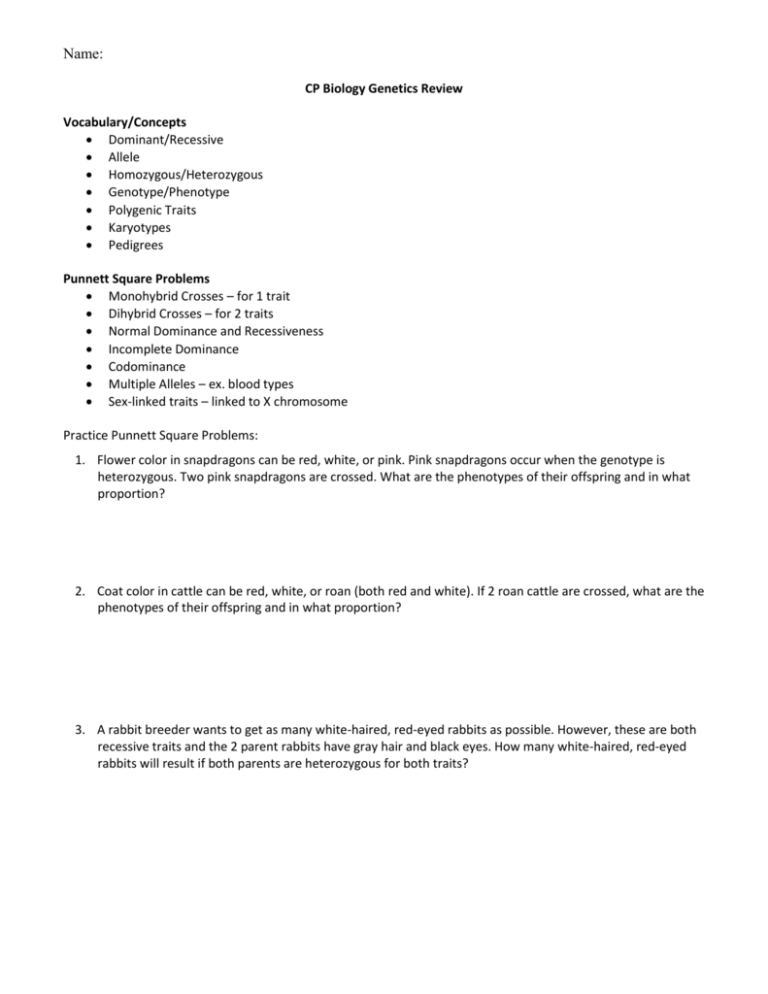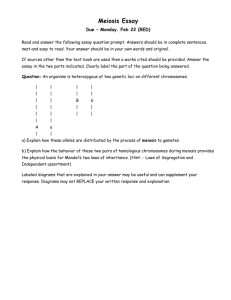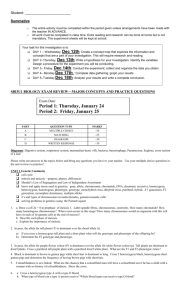Genetics Study Guide
advertisement

Name: CP Biology Genetics Review Vocabulary/Concepts Dominant/Recessive Allele Homozygous/Heterozygous Genotype/Phenotype Polygenic Traits Karyotypes Pedigrees Punnett Square Problems Monohybrid Crosses – for 1 trait Dihybrid Crosses – for 2 traits Normal Dominance and Recessiveness Incomplete Dominance Codominance Multiple Alleles – ex. blood types Sex-linked traits – linked to X chromosome Practice Punnett Square Problems: 1. Flower color in snapdragons can be red, white, or pink. Pink snapdragons occur when the genotype is heterozygous. Two pink snapdragons are crossed. What are the phenotypes of their offspring and in what proportion? 2. Coat color in cattle can be red, white, or roan (both red and white). If 2 roan cattle are crossed, what are the phenotypes of their offspring and in what proportion? 3. A rabbit breeder wants to get as many white-haired, red-eyed rabbits as possible. However, these are both recessive traits and the 2 parent rabbits have gray hair and black eyes. How many white-haired, red-eyed rabbits will result if both parents are heterozygous for both traits? Name: 4. The allele for coat color in cats is carried on the X chromosome. A calico cat has an allele for orange and an allele for black. If a calico cat (female) and a black cat are crossed, what are the phenotypes of the offspring? 5. Color-blindness is a sex-linked recessive disorder. If Don is not colorblind and his wife, Betty, is not colorblind, would it be possible for them to have children who are colorblind? Show the cross to prove it. 6. Two people, one heterozygous for type A blood and one who is homozygous for type B blood have children. What are the possibilities of blood types for their children and in what proportion? Karyotype Questions 7. What information can be gained from a karyotype? (name 2) 8. What information cannot be gained from a karyotype? 9. What are autosomes? How many do humans have in each cell (except for the sex cells)? 10. Do genetic disorders that affect the autosomes or sex chromosomes have a more serious outcome? Why? 11. What term is used to describe a cell that has received three copies of a chromosome (instead of 2)? 12. Discuss one example of a genetic disorder that you learned about from the karyotype Gizmo. 13. The sex chromosomes for human females are _______. The sex cells for human males are ________. What is different about the two sex chromosomes? Name: Practice Pedigrees 14. As a top research scientist, you and your colleagues have discovered a new sex-linked recessive condition. In the course of your research, you have come across a pedigree (see below) for a family in which the condition occurs. a) Which individuals in the pedigree can you be certain are carriers of the allele? Explain your reasoning. b) If individual III-3 has a son with a woman who is not a carrier of the allele, what is the probability that the son will have the condition? Explain. Then, add those two individuals to the pedigree. 15. Marfan syndrome is an inherited condition that affects the connective tissue, resulting in unusually long bones and spinal curvature, as well as vision, cardiac, and respiratory problems. The syndrome tends to become increasingly severe over time. The following pedigree shows inheritance of Marfan syndrome in a multigenerational family. a) How is this syndrome inherited? b) Can you determine individual II-4’s genotype? Explain. c) Individual II-1 and II-2 are considering having another child. What is the probability that this child will have Marfan syndrome? Explain using a Punnett square. Name: Meiosis Review 16. How many daughter cells does meiosis produce? What is the ploidy of these cells? 17. What types of cells are produced from meiosis? 18. Define: diploid haploid gamete zygote 19. Describe crossing over. When does it occur? What is the result? 20. What distinguishes Meiosis I from Meiosis II? (i.e. what is different about the two divisions?) 21. How is meiosis different in males vs. females? How are the processes similar? 22. If an organism has 48 chromosomes in its body cells, how many chromosomes are present in an egg cell? sperm cell? 23. If an organism has 48 chromosomes in its body cells, how many chromosomes are present in the zygote? 24. Make the connection - Explain how our understanding of meiosis allows us to make Punnett square diagrams.








